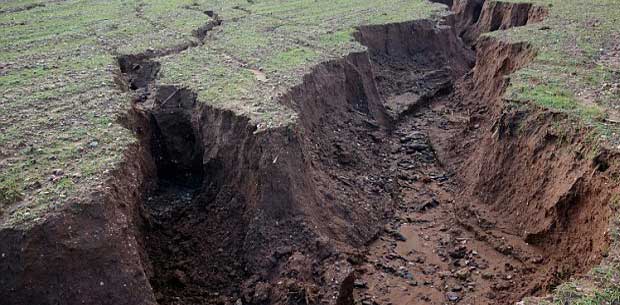
Soil is considered one of the reusable materials for the survival to life on earth. Soil is the topmost layer of the earth, formed due to mechanical disintegration & chemical decomposition of rock materials. It is estimated that formation of one centimetre of soil requires several years. Large amounts of top soil are carried away due to precipitation, wind, flowing rivers, glaciers etc.; this is known as soil erosion.
Contents:
Agents of Soil Erosion
There are various agents which causes soil erosion. Some of them are discussed below:
- Wind: In arid areas, wind is a powerful agent of soil erosion. During summer soils become dry and light. Whenever a powerful wind blows soil particles, they are carried to considerable distances. Soils in deserts are often carried away and the sand particles deposited in adjacent agricultural soil. The rate of wind erosion depends on the strength and direction of the wind and weight or size of the soil particles.
- Rainfall or precipitation: Rainfall is one of the important agents of soil erosion. When water molecules fall onto the soils and weathered rocks, the soil particles become wet and are carried away in the flow of water. The rate of soil erosion depends on the type and duration of precipitation and the nature of the soil.
- Rivers: Run-off water carries away weathered particles. Streams, rivers etc, transport the fine soil particles and deposit them in lakes and reservoirs.
- Deforestation: Trees protect soils from erosion. Heavy precipitation cannot hit the soil directly. It is estimated that in newly deforested areas in tropical regions, organic matter is lost at the rate of 20 to 65 percent per annum. The presence of organic matter in the soil is vital for good water retention and growth of flora. Good water retention reduces soil erosion.
Types of soil erosion
Large quantities of valuable soil are eroded by flowing water and moving wind. Soil erosion of these types mainly takes place by two methods: a) Sheet erosion and b) Gully erosion.
Sheet erosion
This depends on the rate and amount of run-off water and erodability of soils. Sheet movement of running water causes sheet erosion, which has eroded layers from hill slopes. In unprotected land and overgrazed soils unpacked grains are carried away by running water. Sheet erosion is common in the foothills of the Himalaya, Western Ghats & Eastern Ghats.
Gully erosion
In gentle topographical areas covered by vegetation weathered soil and clay particles will resist erosion. Hence, the water forms small rivulets which, in turn, erode a deeper layer of the soil. Rivulets form larger channels and gradually erode the soil. This activity leads to the formation of bad-land topography.
Effects of Soil Erosion
Equilibrium occurs in nature between the climate (chiefly rainfall and temperature) of a place and the vegetation cover which protects the layer of soil. Grass, shrubs and trees retard the transportation of soil. Some amount of erosion takes place even under this natural cover, but it is very slow and is compensated by the formation of fresh soil by ordinary processes of natural weathering. This type of erosion is therefore of little consequence because there is balance between the disintegration of rocks and the subsequent formation of soil. Rate of change is upsetting when balance is destroyed and accelerated erosion takes place. Man is mainly responsible for setting in motion these changes through deforestation, cultivation and steep slopes, unrestricted grazing, indiscriminate drainage operations and denuding forests.
Soil erosion or the denudation results in severe floods and increased scouring. Such floods are a source of danger for road and rail bridges, irrigation and navigation canals, storage reservoirs, hydroelectric projects and water supply & pumping stations.

